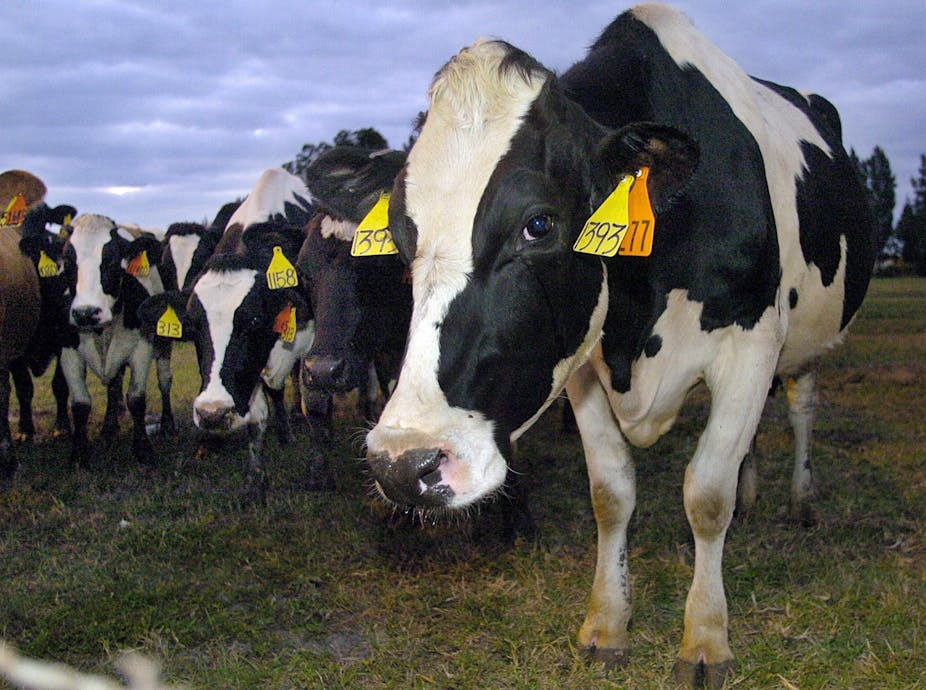Milk, a precious resource in many parts of the world, has become a throwaway commodity in wealthy countries. For example, in the UK, an estimated 4.2m tonnes of foodstuffs wasted per year are wasted, of which milk is in the top three. In 2012, the country disposed of 420,000 tonnes of avoidable dairy and egg waste, costing £780m; perhaps no surprise as supermarkets retail milk for as little as 44p per litre. Bottled water can be two to three times the price.
Such extreme market forces lead to vanishing profit margins, so the dairy industry has had to become super-efficient: fewer, larger herds typically with several hundred, high-yielding Holstein cows capable of producing 10,000 litres per annual lactation cycle, milked by a single dairyman.
These remarkable cattle are the result of highly selective breeding over many generations using a very small pool of elite bulls capable of producing over a million offspring by artificial insemination. A marvellous exemplar of sustainable intensification and food security though application of modern science and technology … perhaps?
From another perspective, the industry has boxed itself into a tight and uncomfortable corner. Modern Holstein dairy cows only last for two to three lactations, rather than the five to eight (or more) of more traditional systems. These animals carry a heavy burden of nutritional and metabolic diseases and poor fertility, often with adverse consequences for welfare that require routine treatment with antibiotics and hormones – all justifiably of concern to the consumer. An average of 37% of Holstein cattle suffer from painful lameness, significantly more so than other breeds.
The Holstein cow is arguably the world’s least fertile farm animal. Around 60% require hormonal treatments for successful pregnancy, an obvious prerequisite to the annual calving and lactation cycle. These treatments may not be harmful to consumers, but routine use of hormones for growth promotion in farm animals was banned in the EU in 1988, and consumers are ill-informed about the risks involved.
The prodigious milk yield of Holstein cows involves consumption of energy and protein far beyond the levels available from pasture. They must be fed a grain-rich diet they are ill-equipped to digest, consuming in a single lactation more than their own body weight of cereals.
Feeding cereals to multi-stomached ruminants such as cattle negates much of their evolutionary advantage, namely their ability to digest fibrous plant material such as forage, green waste and by-products that are of low nutritional value to species such as pigs, poultry or indeed humans. Importantly, cereals are potential human food and are generally produced using polluting artificial fertiliser. In addition, digestive disorders such as displaced abomasum (one of the cow’s four stomachs) were a relative rarity a generation ago but are now commonplace.
In the UK, a minority of dairy farmers use alternative breeds, such as the British Friesian, Ayrshire, or the Montbéliarde. They yield up to 8,000 litres per lactation, but these cows are more robust and are fed primarily off grass or preserved forage in winter, with a modest level of concentrate supplements at peak lactation.

Lameness, mastitis, metabolic disease and infertility are far less frequent than in intensively managed Holsteins. Welfare is less of an issue and antibiotics are rarely necessary, if used at all. Many of these breeds are dual purpose, so their male calves are suitable for rearing for beef, unlike Holsteins in which males are generally disposed of at birth. Dairy cows fed in pasture also require less inorganic fertiliser for cereal production, with less associated environmental pollution.
A change to a less intensive dairy production system would be in keeping with a broader vision, laying down a number of the basic principles for sustainable livestock. One of the central tenets is reduction in consumption of livestock products by humans, with consumption focussed on quality rather than quantity. It is worth noting that milk and dairy products from grass-fed cattle are higher in N-3 fatty acids, and conjugated linoleic acids.
Finally, much attention has been placed on cattle as a source of methane, accounting for the majority share of the 14.5% of man-made greenhouse gas attributed to livestock. It is difficult to predict the value of managerial change to a less intensive dairy system, but there could be other immediate environmental benefits, such as reduction in artificial fertiliser use. For example, current analysis suggests the overall environmental costs of inorganic nitrogen use in Europe (estimated at €70–€320 billion per year) outweighs its direct economic benefits to agriculture.
The Pareto principle (80:20 rule) is arguably at work here: with the Ayrshire and other less extreme dairy breeds you get 80% of the yield for perhaps only 20% of the welfare cost, and maybe just 20% of the environmental costs too. Given that today’s overweight consumers perceive milk as low-value and currently throw much of it away, having only 80% of today’s supply might not be too high a price for a sustainable future with healthier, happier cows.

